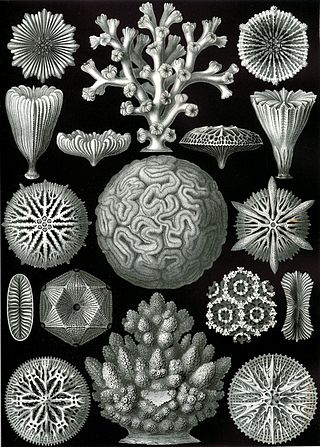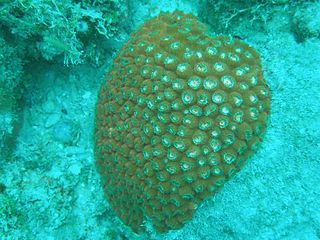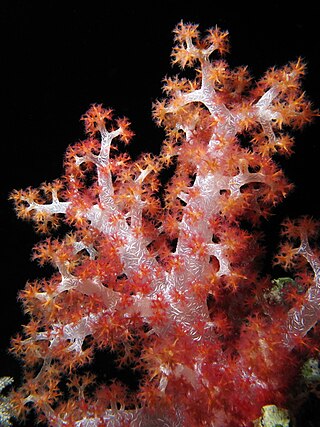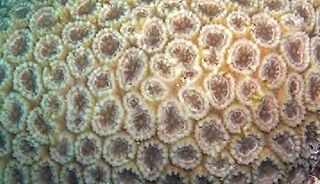
A polyp in zoology is one of two forms found in the phylum Cnidaria, the other being the medusa. Polyps are roughly cylindrical in shape and elongated at the axis of the vase-shaped body. In solitary polyps, the aboral end is attached to the substrate by means of a disc-like holdfast called a pedal disc, while in colonies of polyps it is connected to other polyps, either directly or indirectly. The oral end contains the mouth, and is surrounded by a circlet of tentacles.

Corals are colonial marine invertebrates within the class Anthozoa of the phylum Cnidaria. They typically form compact colonies of many identical individual polyps. Coral species include the important reef builders that inhabit tropical oceans and secrete calcium carbonate to form a hard skeleton.

Scleractinia, also called stony corals or hard corals, are marine animals in the phylum Cnidaria that build themselves a hard skeleton. The individual animals are known as polyps and have a cylindrical body crowned by an oral disc in which a mouth is fringed with tentacles. Although some species are solitary, most are colonial. The founding polyp settles and starts to secrete calcium carbonate to protect its soft body. Solitary corals can be as much as 25 cm (10 in) across but in colonial species the polyps are usually only a few millimetres in diameter. These polyps reproduce asexually by budding, but remain attached to each other, forming a multi-polyp colony of clones with a common skeleton, which may be up to several metres in diameter or height according to species.

Montastraea is a genus of colonial stony coral found in the Caribbean seas. It is the only genus in the monotypic family Montastraeidae and contains a single species, Montastraea cavernosa, known as great star coral. It forms into massive boulders and sometimes develops into plates. Its polyps are the size of a human thumb and fully extend at night.

Acroporidae is a family of small polyped stony corals in the phylum Cnidaria. The name is derived from the Greek "akron" meaning "summit" and refers to the presence of a corallite at the tip of each branch of coral. They are commonly known as staghorn corals and are grown in aquaria by reef hobbyists.

Galaxea fascicularis is a species of colonial stony coral in the family Euphylliidae, commonly known as Octopus coral, Fluorescence grass coral, and Galaxy coral among various vernacular names.

Leptogorgia hebes, commonly known as the regal sea fan or false sea fan, is a species of soft coral in the family Gorgoniidae. It was formerly included in the genus Lophogorgia but that genus has been dismantled.

Siderastrea radians, also known as the lesser starlet coral or the shallow-water starlet coral, is a stony coral in the family Siderastreidae. It is found in shallow parts of the western Atlantic Ocean as small, solid mounds or encrusting sheets.

Acropora secale is a species of branching staghorn stony coral. It is found in shallow parts of the Indo-Pacific Ocean and the type locality is Sri Lanka. The oldest fossils found date back to the Pleistocene.

Euphyllia ancora is a species of hard coral in the family Euphylliidae. It is known by several common names, including anchor coral and hammer coral, or less frequently as sausage coral, ridge coral, or bubble honeycomb coral.

Acropora loripes is a species of branching colonial stony coral. It is common on reefs, upper reef slopes and reef flats in the tropical Indo-Pacific. Its type locality is the Great Barrier Reef.

Pocillopora damicornis, commonly known as the cauliflower coral or lace coral, is a species of stony coral in the family Pocilloporidae. It is native to tropical and subtropical parts of the Indian and Pacific Oceans.

Pocillopora verrucosa, commonly known as cauliflower coral, rasp coral, or knob-horned coral, is a species of stony coral in the family Pocilloporidae. It is native to tropical and subtropical parts of the Indian and Pacific Oceans.

Dendronephthya hemprichi is a common soft coral found from Red Sea to Western Pacific.In may 2023 on the Mediterranean coast of Israel exactly on the coasts of the city of Sdot Yam many specimens were filmed, subsequently it was also photographed in Lebanon In Byblos.It is usually pink or orange with transparent trunk and it grows up to 70 cm. It exists at 30° N latitude. The smallest unit of this coral, like all other corals, is a polyp. This particular species of the Dendronephthya has the ability to reproduce sexually and asexually through broadcast spawning and clonal propagation, respectively.

Dipsastraea speciosa is a species of colonial stony coral in the family Merulinidae. It is found in tropical waters of the Indian and Pacific oceans.

Turbinaria stellulata, also known as disc coral, is a species of colonial stony coral in the family Dendrophylliidae. It is native to the Indo-Pacific region. The International Union for Conservation of Nature has rated its conservation status as being "vulnerable".

Favites pentagona is a species of stony coral in the family Merulinidae, sometimes known as larger star coral. It is native to the Indo-Pacific region and its range extends from the Red Sea through the Indian Ocean to the Western Pacific Ocean. This is a common species throughout its wide range and the International Union for Conservation of Nature has rated its conservation status as being of "least concern".

Rhytisma fulvum, the sulphur leather coral, is a species of colonial soft coral in the family Alcyoniidae. It is native to shallow reefs in the Red Sea and the Indo-Pacific region. It was first described by the Swedish naturalist Peter Forsskål in 1775.

Platygyra lamellina, the hard brain coral, is a species of colonial stony coral in the family Merulinidae. It occurs on reefs in shallow water in the Indo-Pacific region. The International Union for Conservation of Nature has assessed its conservation status as being "near threatened".





















